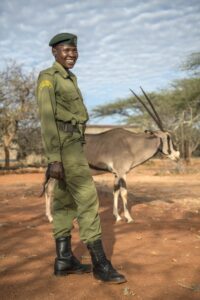
A NRT ranger pose for a photo with a Beisa Oryx | Photo-NRT
By Northern Rangelands Trust (NRT)
The beisa oryx is one of the most stunning animals in the savannah—with its long, graceful horns, a distinctive face mask, and a black side stripe that divides a white belly from a fawn body.
The beisa oryx can reach running speeds of up to 60 kilometers per hour. Males can weigh over 200 kilograms and are typically 115 centimeters tall at the shoulder. The majority of beisa oryx in Kenya are found outside protected areas and are poached and hunted for their high-quality meat and very tough hide, and in pastoralist communities for their horns which are valued as charms and perceived as a source of prestige.
Increased settlement and livestock presence also poses a threat to the beisa oryx and has led to a degradation of their habitat. The distribution of beisa oryx has been impacted by the presence of livestock, causing them to graze at night when livestock is gone and then retreat to safe areas within the conservancy that are restricted from livestock.
With a global estimate of 8,000 to 9,000 individuals, the beisa oryx is categorized as endangered by the IUCN Red list (2021).
Isiolo’s Nakuprat Gotu conservancy is home to one of Kenya’s largest herds of beisa oryx, accounting for at least 10% of the country’s population (following a July 2020 count in which an estimated 880 individuals were recorded).
The conservancy, which is located in Isiolo County, consists of pastoralists from both the Borana and Turkana communities. In the past, there would be a conflict between these two communities.
Today, through the Beisa Oryx Project, they are working together to protect and establish a haven for the beisa oryx population, in collaboration with other conservation partners including the Northern Rangelands Trust (NRT), County Government of Isiolo, and Kenya Wildlife Service (KWS).
During the Project’s launch in May 2021, the community in Nakuprat Gotu vowed to conserve and protect the endangered beisa oryx. With the support of the European Union through IUCN Save Our Species, Nakuprat Gotu is rolling out conservation initiatives and sensitizing communities on the need to safeguard the species from possible extinction.
Since the beginning of the beisa oryx Project, there has been a positive change in the community’s attitude toward wildlife, and community members’ knowledge of the threats facing wildlife has increased.
Resultantly, the number of beisa oryx hunted for meat has declined and their population is gradually growing. The improved wildlife numbers have increased Nakuprat Gotu’s tourism potential and diversified community members’ livelihoods. In addition to protecting wildlife, the beisa oryx Project will equip local youth with vocational skills ranging from masonry, plumbing, motorcycle, and mobile mechanics, carpentry, and welding through the Ujuzi Manyattani Program.
This will ensure that community members have an alternative source of income, deterring them from burning charcoal and hunting down the beisa oryx for commercial reasons.
The beisa oryx Project provides gardening and clearing equipment to 10 school wildlife clubs in the Ngaremara and Gotu areas.
School conservation initiatives related to the Project have so far resulted in the planting of 2,500 trees. This number is expected to rise to 1,000,000 trees by the end of the year.
Thanks to the improved community awareness and buy-in, as well as improved economic opportunities through NRT Trading’s Ujuzi Manyattani Program, the species is being protected and the local herd is growing.
Poaching has stopped almost completely, and the oryx are no longer hunted for their meat. NRT together with Nakuprat Gotu conservancy and its partners are safeguarding the beisa oryx in the hopes of upgrading their status from endangered to threatened.




